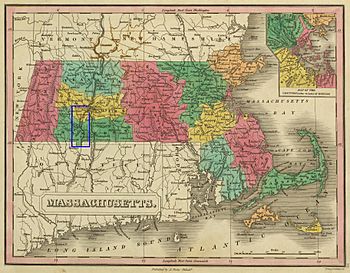Hampshire and Hampden Canal facts for kids
The Hampshire and Hampden Canal was a long waterway built many years ago in the United States. It was part of a bigger canal system that stretched about 86 miles (138 km). This canal connected New Haven, Connecticut, all the way to the Connecticut River north of Northampton, Massachusetts. The part of this canal in Connecticut was known as the Farmington Canal.
Contents
The Big Idea: Connecting States
The idea for this canal started in 1821. Business people in New Haven wanted to build a water route. They hoped to connect their harbor to central Massachusetts. Their big dream was to extend it even further, all the way to Barnet, Vermont, and even into Canada.
The original plan was for the canal to go through Farmington, Connecticut. From there, it would reach the border at Southwick, Massachusetts. Then, it would join the Connecticut River near Northampton. After that, it could continue to the St. Lawrence River. It would pass through Lake Memphremagog and the St. Francis River valley. People also thought about building two smaller canals. One would go from Farmington to Colebrook, Connecticut. The other would link to the Erie Canal using the Hudson River.
Getting Started: Building the Canal
Benjamin Wright, a famous engineer from the Erie Canal, was hired to check the route. In 1822, he said it was a good idea. He reported that the land was perfect for a big project like this. He also thought it would cost less to build than other canals being made in New York.
That same year, the state of Connecticut gave permission (a charter) to the Farmington Canal Company. Then, on February 4, 1823, Massachusetts gave its own permission to the Hampshire & Hampden Canal Company. Once both states agreed, the building work began.
Groundbreaking Ceremony
The official start of construction happened on July 4, 1825. This special event took place right at the border between Massachusetts and Connecticut. The governor of Connecticut, Oliver Wolcott, Jr., used a ceremonial shovel. But the shovel broke in his hands! Some people thought this might have been a sign of trouble to come.
Indeed, both canal companies faced big money problems. They didn't have enough funds to finish the project easily. Despite these difficulties, workers kept building with picks and shovels. By 1828, the canal was open from New Haven to Farmington. This included a major bridge-like structure (aqueduct) over the Farmington River. Finally, by 1835, the entire route to Northampton was finished and ready for use.
How Big Was It?
When the canal was finished, it was about 86 miles (138 km) long. About 56 miles (90 km) of it were in Connecticut. The other 30 miles (48 km) were in Massachusetts.
The canal was 36 feet (11 m) wide at the top of the water. It was 20 feet (6 m) wide at the bottom. The water in the canal was about 4 feet (1.2 m) deep. To help boats go up and down hills, 28 special water elevators called locks were built. These locks helped boats travel up a 292-foot (89 m) rise in elevation between New Haven and Granby. An extra 3.5 miles (5.6 km) of canal were also built to Unionville. This part later helped feed water into the main canal.
Challenges and Changes: The End of the Canal Era
Money problems continued for the canal companies. So, the two companies decided to join together. They formed the New Haven & Northampton Canal Company.
A new challenge appeared in 1838. A railroad, the New Haven Railroad, opened between New Haven and Meriden, Connecticut. Railroads were faster and more reliable than canals. Even though the canal company tried to improve its service in the 1840s, it was hard to compete.
Finally, the canal's owners asked the government for permission to build a railroad on their canal's path. They received permission, and construction started in January 1847. The canal officially closed later that year. By 1848, trains were running from New Haven to Plainville, right where the canal used to be. The company's name stayed the same, and many of the original investors were still involved. Eventually, this company joined with a much larger railroad company, the New York, New Haven and Hartford Railroad, in 1887.


